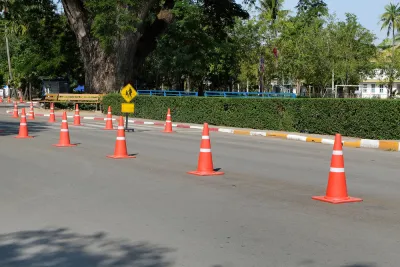The San Francisco Transformation Agency is tired of watching cyclists and pedestrians die while the city promises more Vision Zero improvements.

A group of safety activists came together to implement a DIY safety improvement project at Sixth and Mission in San Francisco "after the deaths of two bicyclists, Heather Miller and Kate Slattery, who were killed the evening of June 22 after being struck by hit-and-run motorists," according to Bryan Goebel.
The action involved placing cones along the street to create a bump-out at a notoriously busy intersection, where pedestrian infrastructure is deteriorating and often ignored by drivers.
The so-called San Francisco Transformation Agency, or SFMTrA, takes inspiration from "similar guerrilla actions in Seattle, Portland and New York," writes Goebel, in moving beyond the Vision Zero efforts of the city. "They point out that despite the city’s Vision Zero effort, which has a goal of ending all traffic deaths by 2024, 26 people have died in traffic collisions so far in 2016," adds Goebel.
In related news at the national level, Angie Schmitt reports that the National Transportation Safety Board (NTSB), usually tasked with investigating train crashes and plane crashes, has finally taken an interest in cycling fatalities. The Systematic Failure blog first noted that NTSB would investigate the fatal crash that killed five people in Kalamazoo, Michigan. Schmitt adds the extra commentary that the NTSB is still missing a larger part of the point:
Some good might come out of this investigation, but how representative is this crash of the 700+ cyclist deaths in the U.S. each year? If the NTSB wants to make a difference for bicycling safety, it should examine the systemic causes of cycling fatalities.
FULL STORY: Spurred by S.F. Cyclist Deaths, Guerrilla Safe Streets Activists Take Action

National Parks Layoffs Will Cause Communities to Lose Billions
Thousands of essential park workers were laid off this week, just before the busy spring break season.

Retro-silient?: America’s First “Eco-burb,” The Woodlands Turns 50
A master-planned community north of Houston offers lessons on green infrastructure and resilient design, but falls short of its founder’s lofty affordability and walkability goals.

Delivering for America Plan Will Downgrade Mail Service in at Least 49.5 Percent of Zip Codes
Republican and Democrat lawmakers criticize the plan for its disproportionate negative impact on rural communities.

Test News Post 1
This is a summary

Test News Headline 46
Test for the image on the front page.

Balancing Bombs and Butterflies: How the National Guard Protects a Rare Species
The National Guard at Fort Indiantown Gap uses GIS technology and land management strategies to balance military training with conservation efforts, ensuring the survival of the rare eastern regal fritillary butterfly.
Urban Design for Planners 1: Software Tools
This six-course series explores essential urban design concepts using open source software and equips planners with the tools they need to participate fully in the urban design process.
Planning for Universal Design
Learn the tools for implementing Universal Design in planning regulations.
EMC Planning Group, Inc.
Planetizen
Planetizen
Mpact (formerly Rail~Volution)
Great Falls Development Authority, Inc.
HUDs Office of Policy Development and Research
NYU Wagner Graduate School of Public Service





























